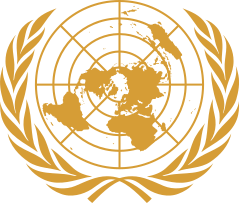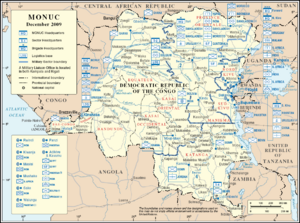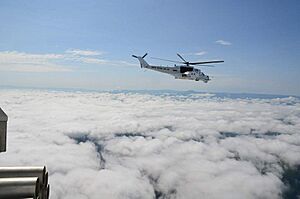MONUSCO facts for kids
Quick facts for kids  MONUSCO |
|
|---|---|
 |
|

MONUSCO deployment in September 2019
|
|
| Org type | Peacekeeping mission |
| Status | Active |
| Headquarters | Kinshasa, DR Congo |
| Subsidiary org(s) | Force Intervention Brigade |
The United Nations Organization Stabilization Mission in the Democratic Republic of the Congo, known as MONUSCO, is a special group of peacekeepers from the United Nations. Its name, MONUSCO, comes from its French name, Mission de l'Organisation des Nations Unies pour la stabilisation en République démocratique du Congo.
MONUSCO works in the Democratic Republic of the Congo (DRC) in Africa. It was created by the United Nations Security Council in 1999 and 2000. Its main job is to help keep the peace and protect people.
At first, MONUSCO helped watch over the peace agreement after the Second Congo War. Later, its focus shifted to other local conflicts. These included the Ituri conflict and the Kivu conflict.
Before 2010, this mission was called MONUC. That name also came from its French name, Mission de l'Organisation des Nations Unies en République démocratique du Congo.
Many countries have sent their military and police to help MONUSCO. Some of the nations that have contributed military personnel include India, Pakistan, Bangladesh, and South Africa. Countries like Bangladesh, Brazil, and Egypt have sent police officers.
The United Nations has spent a lot of money to support this mission. From 1999 to 2010, about US$8.74 billion was used. In 2017, there were around 18,300 UN peacekeeping troops in the DRC.
Contents
MONUSCO's Beginning and Purpose
The idea for MONUSCO came from a peace agreement signed on July 17, 1999. This agreement was called the Lusaka Ceasefire Agreement. After this, the United Nations Security Council decided to send a small group of officers. Their job was to observe and report on how well the peace agreement was being followed.
The first UN officers arrived in the DRC in September 1999. By November 1999, there were 55 officers. They were in different countries involved in the conflict, like Rwanda and Uganda. Their main task was to talk with all the groups fighting. They also helped prepare for more military observers to arrive.
How MONUSCO is Organized
MONUSCO's main office, or headquarters, is in Kinshasa, the capital city of the DRC. The mission divides the DRC into different areas, called sectors. Each sector has its own local headquarters.
In 2005-2006, a special Eastern Division was created in Kisangani. This division took charge of operations in key areas like North Kivu and South Kivu.
MONUSCO is one of the largest UN peacekeeping operations. For example, from July 2007 to June 2008, its budget was US$1.16 billion.
Leaders of the Force
MONUSCO has had several important leaders over the years. These leaders are called Force Commanders. They are high-ranking military officers from different countries.
| From | Force commanders | To |
| March 2000 | Lt Gen Mountaga Diallo (Senegal) | January 2004 |
| January 2004 | Samaila Iliya (Nigeria) | February 2005 |
| February 2005 | Babacar Gaye (Senegal) | July 2010 |
| July 2010 | Lt Gen Chander Prakash (India) | March 2013 |
| April 2013 | Lt Gen Carlos Alberto dos Santos Cruz (Brazil) | December 2015 |
| December 2015 | Lt Gen Derrick Mgwebi SD SM MMM (South Africa) | January 2018 |
| January 2018 | Maj Gen Bernard Commins (France) | June 2018 |
| June 2018 | Lt Gen Elias Martins Filho (Brazil) | January 2020 |
| January 2020 | Lt Gen Ricardo Augusto Ferreira Costa Neves (Brazil) | April 2021 |
| April 2021 | Lt Gen Marcos de Sá Affonso da Costa (Brazil) | 6 September 2025 |
Main Offices in the DRC
MONUSCO has several key offices across the Democratic Republic of the Congo:
- MONUSCO Headquarters: Kinshasa
- Sector 1: Mbandaka
- Sector 2 and Eastern Division HQ: Kisangani
- Sector 3: Kananga
- Sector 4: Kalemie
- Sector 5: Kindu
- Sector 6: Bunia
Peacekeeper Numbers and Safety
In July 2004, there were over 10,500 UN soldiers working for MONUC. By October 2004, the UN Security Council decided to send nearly 6,000 more soldiers.
Peacekeeping can be dangerous work. In February 2005, nine Bangladeshi peacekeepers sadly lost their lives in Ituri province. In May 2006, another Nepali peacekeeper died, and seven were taken captive.
By November 2005, MONUC had grown to more than 16,500 uniformed troops. In July 2006, MONUC forces helped keep the 2006 general election peaceful. This was the first multi-party election in the DRC since 1960.
As of October 2007, MONUSCO had over 18,400 uniformed personnel. This included soldiers, military observers, and police. They were also supported by many civilian staff members.
Sadly, by July 2010, 161 MONUC personnel had passed away while serving the mission. This included soldiers, military observers, police, and civilian staff.
MONUSCO's Staff and Forces
In October 2007, MONUSCO had a total of 18,407 uniformed personnel. This included 16,661 troops, 735 military observers, and 1,011 police. They were supported by 931 international civilian staff, 2,062 local civilian staff, and 585 UN volunteers.
In November 2008, the United Nations Security Council voted to add more peacekeepers. They sent 3,085 more to help with problems in the Nord-Kivu region.
By August 2011, MONUSCO forces included 19,084 uniformed personnel. This number included 16,998 military personnel, 743 military observers, and 1,343 police. There were also many civilian staff and UN volunteers.
As of June 2022, the countries that contribute the most troops are Pakistan, India, Bangladesh, South Africa, Nepal, Indonesia, and Morocco. Together, they contribute nearly 10,000 personnel.
Key Command Staff
The MONUSCO mission is led by important individuals.
- In January 2021, Bintou Keita was chosen to lead MONUSCO. She is also the UN Secretary-General's Special Representative to the DRC.
- Other past leaders include:
- 2018–21: Leila Zerrougui (Algeria)
- 2015–17: Maman Sambo Sidikou (Niger)
- 2013–15: Martin Kobler (Germany)
- 2010–13: Roger A. Meece (USA)
- 2007–10: Alan Doss (United Kingdom)
- 2003–07: William L. Swing (USA)
- 2001–03: Amos Namanga Ngongi (Cameroon)
- 1999–2001: Kamel Morjane (Tunisia)
- The Deputy Special Representatives of the Secretary-General have included Abdallah Wafy (Niger) and Kim Bolduc (Canada).
- The Force Commander has been Lieutenant General Derrick Mgwebi (South Africa).
- The Police Commissioner has been Général Pascal Champion (France).
Countries Helping MONUSCO
Many countries around the world send their people to help MONUSCO. As of March 31, 2022, there were 14,789 people in the mission.
| Country | Police | Experts | Troops and staff officers | Total |
|---|---|---|---|---|
| 0 | 2 | 0 | 2 | |
| 190 | 7 | 1,630 | 1827 | |
| 0 | 0 | 1 | 1 | |
| 24 | 2 | 5 | 31 | |
| 0 | 0 | 0 | 0 | |
| 0 | 4 | 1 | 5 | |
| 0 | 0 | 3 | 3 | |
| 21 | 2 | 3 | 26 | |
| 0 | 1 | 22 | 23 | |
| 5 | 4 | 1 | 10 | |
| 9 | 0 | 8 | 17 | |
| 12 | 0 | 0 | 12 | |
| 0 | 7 | 222 | 229 | |
| 29 | 0 | 0 | 29 | |
| 0 | 2 | 0 | 2 | |
| 0 | 0 | 2 | 2 | |
| 25 | 0 | 0 | 25 | |
| 346 | 7 | 4 | 357 | |
| 1 | 0 | 4 | 5 | |
| 3 | 0 | 2 | 5 | |
| 8 | 11 | 8 | 27 | |
| 0 | 0 | 155 | 155 | |
| 26 | 0 | 1 | 27 | |
| 133 | 17 | 1,890 | 2040 | |
| 4 | 7 | 1,030 | 1051 | |
| 0 | 0 | 3 | 3 | |
| 209 | 4 | 7 | 220 | |
| 5 | 3 | 259 | 267 | |
| 1 | 0 | 0 | 1 | |
| 0 | 3 | 744 | 747 | |
| 0 | 4 | 2 | 6 | |
| 23 | 4 | 0 | 27 | |
| 0 | 2 | 0 | 2 | |
| 2 | 3 | 918 | 923 | |
| 11 | 11 | 1,141 | 1163 | |
| 20 | 1 | 4 | 25 | |
| 1 | 4 | 2 | 7 | |
| 0 | 0 | 1 | 1 | |
| 0 | 14 | 1,961 | 1975 | |
| 0 | 5 | 2 | 7 | |
| 0 | 5 | 1 | 6 | |
| 0 | 0 | 2 | 2 | |
| 0 | 2 | 0 | 2 | |
| 15 | 4 | 4 | 23 | |
| 9 | 6 | 4 | 19 | |
| 437 | 2 | 5 | 444 | |
| 0 | 0 | 1 | 1 | |
| 0 | 0 | 2 | 2 | |
| 0 | 4 | 948 | 952 | |
| 4 | 0 | 0 | 4 | |
| 1 | 0 | 1 | 2 | |
| 16 | 1 | 849 | 866 | |
| 28 | 0 | 0 | 28 | |
| 27 | 1 | 9 | 37 | |
| 9 | 0 | 0 | 9 | |
| 3 | 7 | 255 | 265 | |
| 0 | 0 | 6 | 6 | |
| 0 | 0 | 3 | 3 | |
| 0 | 6 | 828 | 828 | |
| 0 | 3 | 3 | 6 | |
| 0 | 0 | 3 | 3 | |
| Totals | 1,657 | 172 | 12,960 | 14789 |
Civilian Staff at MONUSCO
Besides military and police personnel, MONUSCO also has many civilian staff members. These include international employees, UN volunteers, and people from the Democratic Republic of the Congo. In total, there are 2,636 civilian staff helping the mission.
- International Employees: 816
- United Nations Volunteers: 482
- People from the Democratic Republic of the Congo: 1,338
See also
- Ituri conflict
- Kivu conflict
- Second Congo War
- United Nations Operation in the Congo



